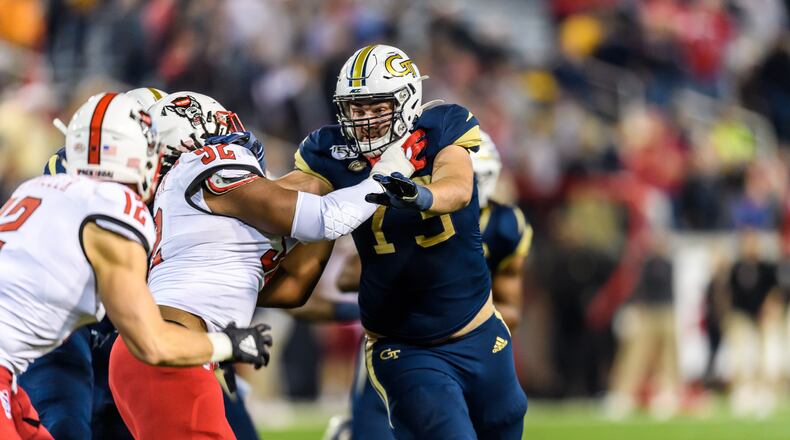When Georgia Tech offensive tackle Zach Quinney went through his first spring practice a year ago with coach Geoff Collins and offensive-line coach Brent Key, any chicanery that the defensive line tried was bound to succeed, the junior said.
A year later, before the shutdown of college athletics because of the coronavirus pandemic, the offensive front had made noticeable strides in recognizing and handling defensive line stunts, in which linemen crossed paths on their way to the quarterback to confuse offensive linemen expecting to block one player and instead having to block another.
“So much better, so much better,” Quinney said with a laugh after a spring-practice session in March before college games and practices were halted. “Last year, if (the Tech defense) would have done what they’re doing now, we just would have walked back to the huddle and been like, OK, I really don’t know what to do.”
Time will tell when Quinney and his Yellow Jackets teammates will return for practices and games. Until then, the Tech offensive line can take encouragement from its play in the spring, when its development in pass protection was noticeable.
“It really started right back after the Georgia game,” Quinney said. “We all got together, and we’ve been working ever since then on stuff like that, just working on footwork and technique and coming together.”
Tech finished last season ranked 105th in FBS in sack percentage, according to teamrankings.com. It was the product of, among other things, a new scheme, facing eight teams in the top 20 in sacks per game and multiple injuries to an offensive line that already was thin and inexperienced.
Still, tossing out the Jackets’ all-around egregious performance against Virginia Tech, Tech threw 58 passes in the other three games in the final one-third of the season and allowed one sack. In the first four games of the season, Tech threw 87 times and permitted 12 sacks.
Two plays help illustrate that progress. The critical play in the overtime period of the loss to The Citadel in the third game of the season was a third-down sack on a poorly-handled blitz. On the play, three Tech offensive linemen directed their attention to a blitzing linebacker, leaving a defensive end unencumbered to sack quarterback Lucas Johnson.
By season’s end, Tech’s effectiveness in handling pass-rush pressure appeared improved. While far from perfect, linemen were able to recognize and react to line stunts better than they had earlier in the season.
One such play resulted in an incomplete pass, but on a third-down play in the second quarter against N.C. State, the Wolfpack put five defenders on the line and brought a sixth from the linebacker level. Tech’s five linemen all engaged the five rushing defenders, keeping them at bay from quarterback James Graham. When an N.C. State defensive end looped behind a tackle beside him, right tackle Jared Southers and right guard Mikey Minihan traded off assignments without missing a beat. At the same time, running back Jordan Mason identified and picked up the blitz coming up between left guard Jack DeFoor and center William Lay, giving Graham the time and space to drop back, plant and throw deep.
“The anticipation factor is what our guys, I do think, are doing a better job of,” Key said. “Anticipating what’s about to occur so they can put themselves in a better position to go out and execute.”
Should the season be played and the Jackets recover their form, Tech’s pass protection ought also to improve for two other notable reasons besides the progress of the returnees. Grad-transfer offensive linemen Ryan Johnson (Tennessee) and Devin Cochran (Vanderbilt) – they started a combined 51 games at their former schools and more than held their own – both look like they will upgrade Tech’s line. Second, the line had put on significant weight by spring practice.
“I can feel it out here playing,” said Quinney, who went up from 290 pounds at the end of the season to 305 in spring practice. “It’s so much better. It’s moving people in a way that I never really could.”
In the college football realm, there are no shortage of variables in the midst of the pandemic, starting with when players might be able to return to campus. More germane to the actual game, how players’ strength and weight has held up, and how much of the technique and schematic knowledge they have retained are two others. Given the linemen’s self-directed sessions in January and February – when they gathered without coaching supervision to work together on footwork and technique – it wouldn’t be surprised if the group returned as ready to close to their previously displayed form as any position group in the ACC.
For now, there’s the hope in the development of the spring, on hold until further notice.
About the Author
Keep Reading
The Latest
Featured


